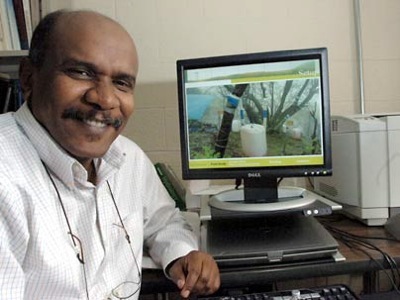Crazy Climate: Are we responsible?

Publication Date: September 22, 1998
Source: MIT Spectrum
Nature was more capricious and dangerous than usual this past summer.
Parts of the Southwest saw temperatures soar past 100 degrees for weeks at a stretch, claiming the lives of the vulnerable and turning farm regions into dust bowls. Drought-stricken Florida sustained 2,000-plus forest and brush fires. Many other U.S. regions witnessed ferocious and in some cases death-dealing floods. And there were natural calamities elsewhere, from China’s Yangtze River–which overflowed its banks in lethal fashion–to Moscow, swept by storms packing hurricane-force winds.
Many such events were blamed on El Niñ, the periodic warming of the Pacific’s waters along the equator that causes standard wind patterns over that ocean to reverse course. Some who think global warming is already here, meanwhile, saw the fingerprints of that climatic change on many of this summer’s natural happenings.
But MIT’s Elfatih Eltahir, associate professor of civil and environmental engineering, says we don’t fully understand the roots of the weird climatic events. “We are experiencing a lot of extreme variability,” he says, “but it’s not clear what all the factors behind it are.”
Drought’s dire impacts
Eltahir is a hydrologist–a student of water and its behavior. His specific focus is the cycles of flood and drought that many regions are prey to. He believes such studies will reveal what’s normal, thus in turn helping us figure out humankind’s impacts on climate.
Hydrology was in some ways a natural choice for Eltahir. He grew up a stone’s throw from the Nile River in Africa’s Sudan. The region is subject to severe droughts, with the villages heavily dependent on rainfall typically the hardest hit, says the faculty member. He recalls village residents bringing their weakened livestock with them into the cities, where the ailing animals “would be sold for any price their owners could get.”
Since earning his MIT doctorate in 1993, Eltahir has enjoyed marked success in his chosen field. Last year, for example, he won one of the prestigious Presidential Early Career Awards for Scientists and Engineers, given out annually by the White House.
“He’s an original and independent thinker,” says Rafael Bras, chair of the civil and environmental engineering department. “He’s come up with new interpretations of natural events that are very, very powerful.”
Eltahir’s field, though, isn’t for the faint-hearted. While popular accounts often compare climate to a “machine,” as if a contraption somewhere were pumping out heat, water vapor and other factors that shape weather cycles, an Earth-sized, vastly complicated organism is more like it. Changes in one part of this system can affect other, far-distant parts. Eltahir, for example, has shown that the Pacific’s El Niñ can boost the odds of a drought along the Nile, among other distant rivers.
Similarly, some events have consequences that wind up reinforcing the effects of the original occurrence. Heavy rains in the Midwest increase the soil’s sogginess in springtime, leading to larger-than-otherwise rain totals in the summer–a phenomenon Eltahir also helped to uncover.
Virtual climates
Two factors, though, are making it easier to probe climate’s secrets. One is a sharp increase in data, mainly from satellites, on rainfall, soil moisture and other key factors. The second is soaring computer power. “My students,” notes Eltahir, “would never consider using the computer that I did my thesis on.”
Relying on high-powered systems, Eltahir and his students in effect construct virtual patches of Earth, creating sophisticated computer models that offer insights into the factors shaping climate. An early focus was the rain forest on the south coast of the horn of Africa–the part of the continent that juts hundreds of miles out into the Atlantic. “A significant fraction of the forest there has been cut down or burned,” he says, “and the rainfall there has been below normal for the last 20 to 30 years.”
Eltahir wondered if the developments were linked. His tentative but worrisome conclusion: the forest’s destruction is in fact a key reason rainfall levels have plummeted in areas up to 600 miles from the coast.
Eltahir has created virtual climates in other regions, too. He and others are probing the impact of forest losses in the Amazon basin, home to the world’s biggest rain forest. There, swaths whose total approaches 200,000 square miles–two-thirds the size of Texas–have been cleared.
Long-range forecasting
The Amazon studies are too preliminary to reveal whether such losses are cutting rainfall. If the destruction continues, though, the results–and Eltahir emphasizes that at this point the possibility is highly conjectural–could be catastrophic. “You might eventually reach a stage,” he notes, “where there’s a positive feedback, and the forest that remains starts to die off because of a lack of rain.”
Studies like Eltahir’s may have practical pay-offs. Reliable, three-to-six-month rainfall forecasts could permit actions that save not only crops but lives. The toll from the Yangtze floods, for example, might have been far less than 3000-plus had it been clear months ahead of time that flooding risks were high.
The work could also yield a better understanding of the regional impacts of phenomena like a warming of the planet as a whole. “But we first must understand the natural variability of these regional climate systems,” says Eltahir. “Until then, we can’t tell whether the extremes we’re seeing are normal or not.”
–Richard Anthony
